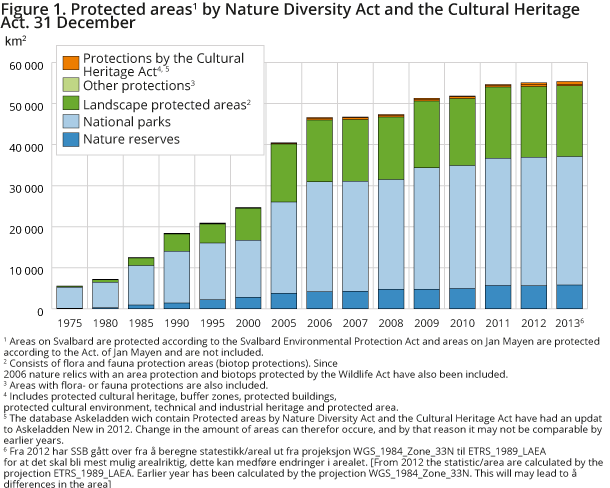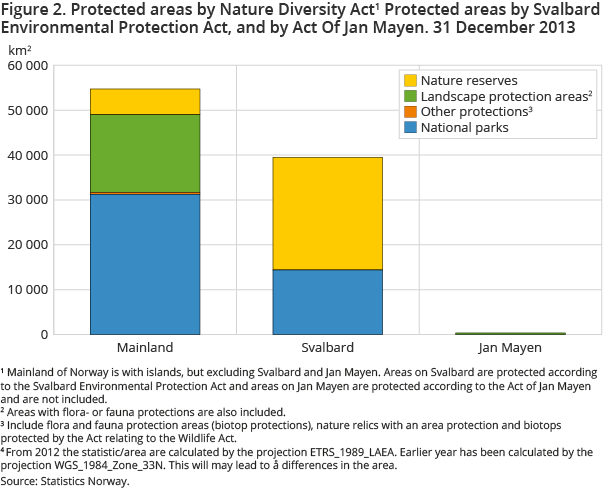Content
Published:
This is an archived release.
New national park in the skerries
A national park was established in the skerries in Vestfold in 2013. Thus, there are now two national parks covering skerry areas.
| 2013 | ||||
|---|---|---|---|---|
| The main land1 | Svalbard og Jan Mayen2 | Svalbard og Jan Mayen2 | ||
| Protected areas (km2) | Number of protected areas | Protected areas (km2) | Number of protected areas | |
| 1Mainland of Norway including islands, but excluding Svalbard and Jan Mayen | ||||
| 2Jan Mayen consist of one nature reserves of 375 km2 | ||||
| Total | 55 296.02 | 190 386 | 39 949.36 | 3 915 |
| National parks | 31 280.89 | 37 | 14 369.44 | 7 |
| Nature reserves | 5 788.26 | 2 051 | 25 492.63 | 22 |
| Landscape protected areas | 17 273.85 | 201 | 0.00 | 0 |
| Other protections | 388.26 | 477 | 13.73 | 1 |
| Protected cultural environments | 54.32 | 8 | 0.00 | 0 |
| Protected cultural heritage | 209.88 | 89 177 | 0.96 | 1 304 |
| Buffer zones | 279.60 | 90 344 | 72.44 | 1 843 |
| Protected buildings | 1.61 | 7 048 | 0.01 | 321 |
| Technical and industrial heritage | 0.02 | 325 | 0.15 | 414 |
| Protected area | 19.33 | 717 | 0.00 | 3 |


The total number of protected areas in Norway now exceeds 194 000, and cover more than 95 250 km 2 of the land area - equivalent to 25 per cent. Protected areas on the mainland made up 17 per cent, and on Svalbard as much as 65 per cent of the land area. On Jan Mayen, almost 99 per cent of the land area is protected.
National parks in the skerries
Færder national park is located at Nøtterøy and Tjøme municipals in the county of Vestfold. The national park covers in total 340 km 2 , of which 325 is located in the sea. Thus, only a very small area of the national park is on land area. Only protected area on land is included in these statistics.
Overall, the national parks have increased by approximately 16 km 2 in 2013. Norway has 44 national parks; 37 on the mainland and 7 on Svalbard. The national parks make up the largest area out of the total protected areas, with 46 000 km 2 , divided between just short of 31 300 km 2 on the mainland and approximately 14 400 km 2 on Svalbard. At the end of 2012, the national parks made up 10 per cent of the land area on the mainland, and 12 per cent of the total area of Norway.
Jan Mayen has one large continuous nature reserve area
There were four new conservations of nature reserves on the mainland in 2013. Nature reserves on the mainland make up a total of about 5 800 km 2 , and cover approximately 2 per cent of the area. On Svalbard, the nature reserves cover more than 25 200 km 2 , and form up to 41 per cent of the group of islands. The most frequently occurring category of conservation form is nature reserve on Svalbard. Jan Mayen has only one nature reserve, although it covers as much as 99 per cent of the land area. Nature reserves make up more than 31 300 km 2 or 8 per cent of the total area in Norway.
Most registered cultural heritage objects on the mainland
The amount of conservation objects in total is almost 191 500 on the mainland and Svalbard combined. Of these, more than 187 600 are located on the mainland, while Svalbard has only 3 900 cultural heritage objects, making up 98 and 2 per cent respectively. On Svalbard, most of the conservation objects are located along the coast, while for the mainland it is the inland counties of Hedmark and Oppland that have the highest number of registered cultural heritage objects. However, the areas of cultural heritage objects make up an insignificant share of the total land area. Jan Mayen does not have any cultural heritage objects.
Buffer zones and archaeological cultural heritage dominates
Buffer zones and archaeological cultural heritage combined dominate the types of cultural heritage, with 176 300, which corresponds to 96 per cent of the total cultural heritage. This is broken down into 173 200 on the mainland and 3 100 on Svalbard.
Buffer zones make up an important part of the amount and the total area of conservation areas on the mainland as well as on Svalbard. The total area of buffer zones is more than 350 km 2 , and increased by 30 km 2 last year. The counties of Finnmark and Svalbard combined have up to 37 per cent of the total buffer zone area, with 56 km 2 and 72 km 2 respectively.
Archaeological cultural heritage increased the area by 15 km 2 last year, and makes up 211 km 2 on the mainland and Svalbard overall. Finnmark also has the largest total area of archaeological cultural heritage, and makes up 24 per cent of the total area of these.
Svalbard does not have a protected cultural environment, and neither do any of the counties.
Pressure on nature and the cultural heritageOpen and readClose
The population growth and modernisation of society have increased the pressure on natural and cultural heritage in recent decades. The Nature Conservation Act and the Cultural Heritage Act are important tools for the authorities in safeguarding a diversity of nature and culture for the future.
Contact
-
Svein Johan Reid
E-mail: sjr@ssb.no
tel.: (+47) 41 51 29 66
-
Jørn Kristian Undelstvedt
E-mail: jorn.kristian.undelstvedt@ssb.no
tel.: (+47) 94 50 68 64
